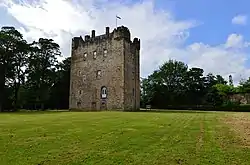Alloa Tower
Alloa Tower in Alloa, Clackmannanshire in central Scotland is an early 14th century tower house that served as the medieval residence of the Erskine family, later Earls of Mar.[1] Retaining its original timber roof and battlements, the tower is one of the earliest, and largest, of Scottish tower houses, with immensely thick walls. It was designated as a scheduled monument in 1960[2] and is now owned by the National Trust for Scotland.[3]
 | |
 Location within Scotland | |
| Established | 14th century |
|---|---|
| Location | Alloa Park, Alloa FK10 1PP, United Kingdom |
| Website | https://www.nts.org.uk/visit/places/alloa-tower |

History
The four-storey tower is 68 feet (21 m) high, excluding the attic. The building is made from coursed rubble and measures 62.5 by 39.5 feet (19.1 by 12.0 m) in size.[2] The building has been extensively re-fenestrated during its history, but retains some internal medieval features.[4]
It was originally built as part of a line of fortifications defending the north shore of the Firth of Forth.[5] Several 19th century works, including Groome's Gazetteer,[6] date the tower to the year 1223.[7] Archaeological investigations from the early 1990s date the original fortified house to the early 14th century, where it had a cellar that sometimes served as a pit prison. By the mid-14th century it had been enlarged with a great hall and rose to three storeys in height, with the entrance on the first floor. In the 15th century it was further enlarged to four/five levels while retaining its first-floor access. Late in the 16th century ground-floor access was probably added.[5]
John Erskine, 6th Earl of Mar built a very large mansion (Alloa House) in 1710 that incorporated the tower as its annexe. Mar wrote:
There is something in the Old Tower, espetially if made to conforme to the new designe, which is venerable for its antiquity & makes not a bad appearance & would make one regret the being obliged to pull it down.[8]
Mar made plans to remodel the tower's interior, but it is unclear what changes were actually made. The house burned down in 1800[5] and was rebuilt by George Angus in 1834–1838 for the 9th Earl. It was demolished sometime after 1868.[2]
Royal history at Alloa
In February 1497 the gardener of Alloa brought trees to plant in the garden at Stirling Castle.[9] Margaret Tudor met the Chancellor James Beaton at Alloa on 11 July 1524, to discuss transferring power from Regent Albany to the young James V.[10]
Mary, Queen of Scots visited the John, Lord Erskine and his wife Annabell Murray at Alloa on 16 June 1562, and again in May 1565. Mary returned to Alloa on 28 July 1566, soon after the birth of Prince James.[11] This visit subsequently attracted the attention of her enemies, and the details are disputed.[12] Mary wrote from Alloa on 31 July to Annabell Murray's brother-in-law, the Laird of Abercairney, on behalf of the evicted widow of one of his tenants.[13] George Buchanan later wrote that she came by boat from Newhaven, crewed by "notorious pirates", associates of the Earl of Bothwell including William and Edmund Blackadder. Darnley came to Alloa by land but she told him to go away.[14] It is also said she went to Stirling in disguise dressed as an ordinary townswoman "in homely sort" and joined in a dance around the Market Cross.[15]
In December 1592 the widower John Erskine, Earl of Mar married Marie Stewart a daughter of Esmé Stewart, 1st Duke of Lennox, and the wedding celebrations were held at Alloa. James VI of Scotland and Anne of Denmark gave the bride clothes, and there was a masque in costume in which Anne of Denmark performed, dressed in silk taffeta and "gold tock".[16] The festivities were cut short when Sir John Carmichael and Sir George Home arrived from Edinburgh with news of the crisis caused by the discovery of the Spanish blanks.[17]
References
- "Alloa Tower". Gazetteer for Scotland. Retrieved 29 March 2013.
- Historic Environment Scotland. "Alloa Tower (LB20959)". Retrieved 17 March 2020.
- "Alloa Tower". Visit. National Trust for Scotland. 20 March 2020. Retrieved 20 March 2020.
- MacGibbon, David; Ross, Thomas (1889). The Castellated and Domestic Architecture of Scotland, from the Twelfth to the Eighteenth century. Vol. 1. Edinburgh: David Douglas. pp. 155–156. Retrieved 11 October 2017.
- "Alloa Tower | Canmore". canmore.org.uk. Retrieved 18 March 2020.
- "Alloa". The Gazetteer for Scotland. Retrieved 31 October 2017.
- Ballingall, William (1872). The Shores of Fife. Edinburgh: Edmonston & Douglas. pp. 54–57. Retrieved 31 October 2017.
- Charles Wemyss, Noble House of Scotland (Prestel Verlag, 2014), p. 228.
- Thomas Dickson, Accounts of the Treasurer, vol. 1 (Edinburgh, 1877), p. 377.
- Ken Emond, The Minority of James V (Edinburgh, 2019), p. 174: State Papers Henry VIII, vol. 4 part 4 (London, 1836), pp. 83-4.
- Edward Furgol, 'Scottish Itinerary of Mary Queen of Scots, 1542-8 and 1561-8', PSAS, 117 (1987), microfiche, scanned
- John Guy, My Heart is My Own: Mary, Queen of Scots (London, 2004), p. 270.
- Historic Manuscripts Commission 3rd Report (London, 1871), p. 418.
- James Aikman, History of Scotland by George Buchanan, vol. 2 (Glasgow, 1827), pp. 485-6
- R. H. Mahon, Mary, Queen of Scots, a study of the Lennox Narrative (Cambridge, 1924), pp. 122-3.
- Michael Pearce, 'Anna of Denmark: Fashioning a Danish Court in Scotland', The Court Historian, 24:2 (2019) pp. 146, 148-9: Robert Chambers, Domestic Annals of Scotland, vol. 1 (Edinburgh, 1848), p. 244: HMC Salisbury Hatfield, vol. 4 (London, 1892), p. 252.
- Michael Pearce, 'Maskerye Claythis for James VI and Anna of Denmark', Medieval English Theatre 43, 2021 (Cambridge: D. S. Brewer, 2022), pp. 121-122 doi:10.2307/j.ctv24tr7mx.9: Thomas Thomson, The historie and life of King James the Sext (Edinburgh, 1825), p. 260.